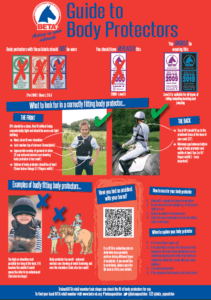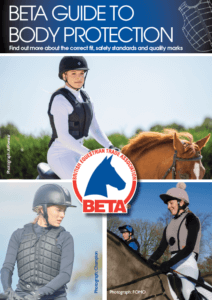Body protection made easy
From January 2024 the 2009 standard will no longer be permitted to use for BE, BRC, PC

Whether you’re planning to go eventing, about to back a young horse or just go out hacking, consideration should always be given to body protection.
Designed to absorb impact from a fall or kick from a horse, body protectors are compulsory for some competitions. But an increasing number of riders report feeling more confident – and therefore riding more positively – when wearing one in everyday situations from hacking to schooling over fences.
Another reason many more riders are opting for body protection is that modern garments are more flexible and lightweight than their predecessors. Not only that, 21st century body protectors come in fun, fashionable colours (or plain if you prefer), are quick and easy to put on – and don’t necessarily cost as much as you may think.
A good fit is the key to comfort and safety. BETA trains retailers to fit body protectors so that they can offer riders free, personalised fittings.
What’s the best body protector for you?
BETA originally brought together riding organisations, doctors, riders, manufacturers and retailers to develop the now widely recognised BETA Body Protector Standard.
The 2018 Body Protector Standard meets all the requirements of the respective European standard (EN 13158). A revised edition of the BETA standard was published and adopted by BETA in 2018 as the new BETA standard.
In performance terms there is no difference in the amount of protection offered by the 2009 and 2018 versions. The 2009 version ceased to be manufactured at the end of 2018, and some of the disciplines and rider organisations from January 2024 will no longer recognise and accept it. Please note that British Eventing have given a grace period until 8 April for garments to be replaced to meet the new rules.
As rules have to apply to all garments with the same label, the decision was made to withdraw permission for the older version of the standard due to the potential age that some of the oldest garments being worn could have reached – up to 13 years old.
Garments labelled 2009 when bought new can be used for hacking and many other activities where there is no stipulation for the later version.
Under the BETA Standard, garments are additionally re-tested annually for consistency of quality of materials used and manufacturing processes. We would recommend that if you are looking to purchase a new body protector now that you look for garments with the 2018 label on them.
The BETA Standard sets criteria for shock-absorption, controls the area of the body that must be covered and ensures there are minimal gaps between the protective foam panels. It encompasses three levels, each designed for different activities and denoted by a colour-coded label on the garment.
• Level 1 – provides the lowest level of protection that is only considered appropriate for licensed jockeys. Level 1 is designed to meet the weight restrictions that apply to professional jockeys whilst racing.
• Level 2 – offers a lower than normal level of protection. It is considered suitable for general riding in very low risk situations and for professionals such as licensed jockeys when specified by their racing authority or regulatory body.
• Level 3 – is considered appropriate for general riding, competitions including eventing and working with horses. Level 3 body protectors should prevent minor bruising that would have produced stiffness and pain, reduce soft tissue injuries and prevent a limited number of rib fractures.
There is a separate BETA Standard for shoulder protectors. Research into falls onto the shoulder during eventing competitions revealed that wearing shoulder protection reduces the risk of breaking your collarbone by up to 80%.
Make the most of your body protector
Body protectors should be replaced at least every three to five years, depending on frequency of use and how well the garment has been cared for. After 5 years the impact absorption properties of the foam may have started to decline and if the garment sustains impacts through falls, then the ability of the foam to absorb future impacts will have been compromised.
Garments bearing the now obsolete Level 5 or 7, Class 1, 2 or 3 labels and BETA 2000 Level 1, 2 or 3 should not be worn. You should be wearing a garment bearing the current BETA 2018 Standard.
If you should have a heavy fall, your body protector should be checked immediately for dents. The foam will expand back to its original shape within 30 minutes; but if a dent is showing on examination, then it’s likely that this part of the garment has lost its impact absorption properties and should be replaced.
Hidden damage that a body protector may have sustained is also a good reason for avoiding second-hand garments or those with unknown histories. Taking good care of your body protector means that it will last longer within the three to five year recommended lifespan. So don’t leave it lying around at the yard or in the lorry to be chewed and trodden on. Spending too much time in a hot car or damp tackroom won’t do it any good either.
When not in use, body protectors should be hung on a clothes hanger. Doing up zips ensures they keep their shape, while closing Velcro fastenings will help prevent them becoming clogged with horse hair and hay particles.
Most body protectors are made from heat sensitive PVC nitrile foam, which is why they feel increasingly comfortable as they soften and mould to the wearer’s body. So try storing your protector in a warm (but not artificially hot) environment to ensure it’s nice and flexible for that early morning ride.
Free fittings
Visit a BETA-trained retailer – indicated by a BETA Safety Certificate displayed in-store – to get a free, personalised fitting of your new body protector.
BETA runs regular courses to train retailers in the construction, correct use, fitting and maintenance of body protectors – specialist information they can pass on to you when you visit their tack shops or show stands.
BETA training, some of which is also open to professionals such as instructors, regularly takes place across the UK and Ireland.
So look for the BETA Safety Certificate, and ask for the member of staff named on it to guide you in the selection your new body protector. They will be only too pleased to help, and this unique service won’t cost you a penny more than the price of the garment.
To find your nearest BETA-trained retailer, telephone +44 (0) 1937 587062, email tina@beta-uk.org or search the BETA members database for trained members.



